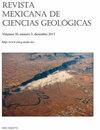Litofacies y mineralogía de los depósitos de sínter de la zona geotérmica de San Agustín del Maíz, Michoacán, México
IF 0.5
4区 地球科学
Q4 GEOSCIENCES, MULTIDISCIPLINARY
Revista Mexicana De Ciencias Geologicas
Pub Date : 2020-11-24
DOI:10.22201/cgeo.20072902e.2020.3.1585
引用次数: 1
Abstract
In the active San Agustín del Maíz geothermal zone (Michoacán), we identified silica-sinter deposits co-existing with hot springs. Considering the deposition mode, these deposits are separated into fracture-banded and bedded deposits. The first ones are associated with deposition on the channels from the fluids rising to the surface, while the second ones are formed from the geothermal fluids that reached the surface. The bedded deposits showed different types of lithofacies grouped in a range with two endmembers: on the one hand, a pure silica-sinter deposit characterized by high density, glassy aspect and being consolidated. On the other hand, a silty-sandy deposit, that easily disaggregate, presenting impression of plants and lithics. The vitreous deposit is considered geyserite, formed from fluids with temperatures superior to 70 °C, while the silty-sandy deposits are formed from fluids with temperatures below 70 °C and, in some cases, far away from the water source. The geyserite deposits are mineralogically composed only by opal (C and CT), while the silty-sandy deposits are formed by opal in association with other mineralogical phases (linked to sediments). Consequently, we recognized that the lithofacies and the mineralogy of the silica-sinter deposits give information of the temperatures and deposition rates of the parental fluids. This information could be very useful in order to identify setting where existed grater geothermal up flow and temperature (e.g. geiserite Litofacies y mineralogía de los depósitos de sínter de la zona geotérmica de San Agustín del Maíz, Michoacán, México Emmanuel Olvera-García1, 2,*, Víctor Hugo Garduño-Monroy1, Mikhail Ostrooumov1, Gerardo Bermejo-Santoyo1, Jorge Alejandro Guevara-Alday3, Andrea Brogi2 y Domenico Liotta2 1 Universidad Michoacana de San Nicolás de Hidalgo, Instituto de Investigación en Ciencias de la Tierra, Morelia, Michoacán, México. 2 Università degli Studi di Bari, Dipartimento di Scienze della Terra e Geoambientali, Bari, Italia. 3 University of Quebec in Montreal, Department of Earth and Atmospheric Science, Montreal, Canada. * emmanuelog_08@outlook.com REVISTA MEXICANA DE CIENCIAS GEOLÓGICAS v. 37, núm. 3, 2020, p. 212-223 I: htt ://dx.doi.org/10.22201/cgeo.20072902e.2020.3.1585 213 Sínter de la zona geotérmica de San Agustín del Maíz, Michoacán, México RMCG | v. 37 | núm. 3 | www.rmcg.unam.mx | DOI: http://dx.doi.org/10.22201/cgeo.20072902e.2020.3.1585 a) b) Depósitos lacustres y aluviales Mio-Holocénicos Volcanes y productos volcánicos (de ácidos a básicos) del Mioceno tardío al Holoceno Lavas (andesíticas y basálticas) y depósitos ignimbríticos del Mioceno medio y tardío Fallas de normal a oblicua izquierda Falla de lateral a oblicua 3.墨西哥michoacan San agustin del maiz地热带烧结矿的岩相和矿物学
在活动的San Agustín del Maíz地热带(Michoacán),发现了与温泉共生的硅粉烧结矿床。从沉积方式来看,这些矿床可分为裂缝带状和层状矿床。前者与上升到地表的流体在通道上的沉积有关,而后者是由到达地表的地热流体形成的。层状矿床表现为不同类型的岩相组合在一个范围内,具有两个端元:一方面为纯硅烧结矿床,具有高密度、玻璃质、固结的特征;另一方面,粉砂质沉积物,很容易分解,呈现出植物和岩屑的印象。玻璃质沉积物被认为是硅辉石,由温度高于70°C的流体形成,而粉砂质沉积物由温度低于70°C的流体形成,在某些情况下,远离水源。硅辉石矿床在矿物学上仅由蛋白石(C和CT)组成,而粉砂矿床则由蛋白石与其他矿物学相(与沉积物有关)共同形成。因此,我们认识到硅烧结矿床的岩相和矿物学提供了母流体的温度和沉积速率的信息。这些信息可能非常有用的以识别设置,刨丝器存在地热流和温度(例如geiserite Litofacies y mineralogia de los depositos de烧结de la带geotermica德圣奥古斯汀•德尔玉米,米却肯州,墨西哥Emmanuel Olvera-Garcia1 2, *,维克多雨果Garduno-Monroy1,米哈伊尔•Ostrooumov1 Gerardo Bermejo-Santoyo1 Jorge Alejandro Guevara-Alday3 Andrea Brogi2 y Domenico Liotta2 1大学圣尼古拉•米德·德·伊达尔戈,Investigación拉地拉科学研究所,莫雷利亚,Michoacán,墨西哥。2巴西巴里大学地球环境科学学院,意大利巴里。3加拿大蒙特利尔魁北克大学地球与大气科学系,加拿大蒙特利尔。* emmanuelog_08@outlook.com墨西哥科学研究GEOLÓGICAS v. 37, núm。3, 2020, p. 212-223 [j]: http://dx.doi.org/10.22201/cgeo.20072902e.2020.3.1585 213 Sínter de la zona geot ), Maíz, Michoacán, m - - - - - RMCG | v. 37 | núm。3 | | DOI: www.rmcg.unam.mx http://dx.doi.org/10.22201/cgeo.20072902e.2020.3.1585) b) Depositos lacustres y aluviales Mio-Holocenicos volcan y或volcanicos(类basicos) del Mioceno tardio al Holoceno熔岩(andesiticas y basalticas) y Depositos ignimbriticos del Mioceno五分镍币y tardio法拉德正常oblicua izquierda法拉德横向oblicua 3。
本文章由计算机程序翻译,如有差异,请以英文原文为准。
求助全文
约1分钟内获得全文
求助全文
来源期刊

Revista Mexicana De Ciencias Geologicas
地学-地球科学综合
CiteScore
1.00
自引率
12.50%
发文量
0
审稿时长
6-12 weeks
期刊介绍:
Revista Mexicana de Ciencias Geológicas (RMCG) publishes original research papers on geological processes of broad interest, and particularly those dealing with regions of Latin America. The RMCG also publishes review papers on topics of current interest, and on the geology and tectonics of geological provinces of Latin America. Besides, it offers the opportunity for host editors to publish special thematic issues.
 求助内容:
求助内容: 应助结果提醒方式:
应助结果提醒方式:


